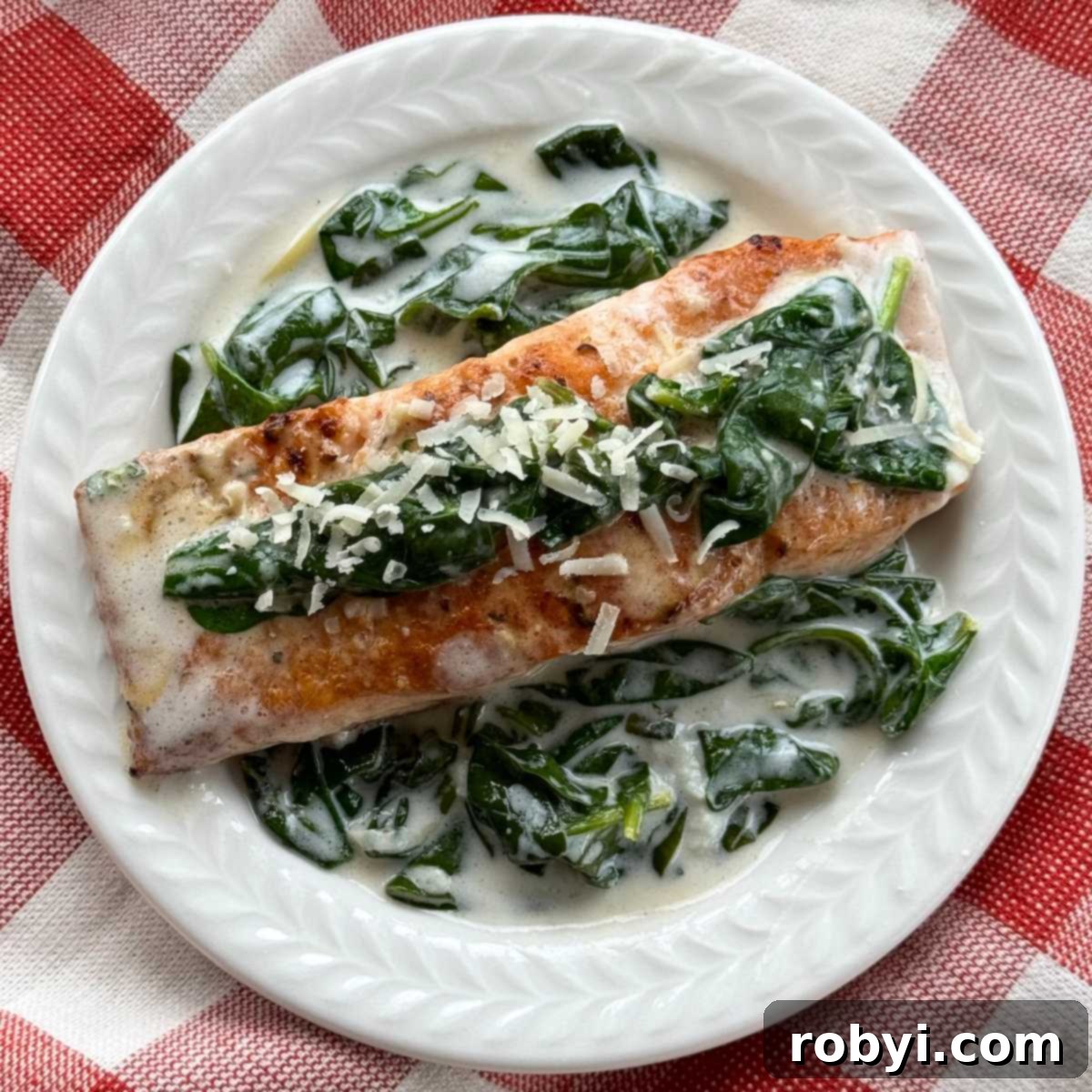Transform your weeknight dinner into an elegant culinary experience with this incredibly easy Salmon Florentine recipe. Featuring perfectly cooked salmon nestled in a creamy Parmesan sauce infused with fresh spinach, this dish comes together in just 30 minutes, all in a single pan on your stovetop!
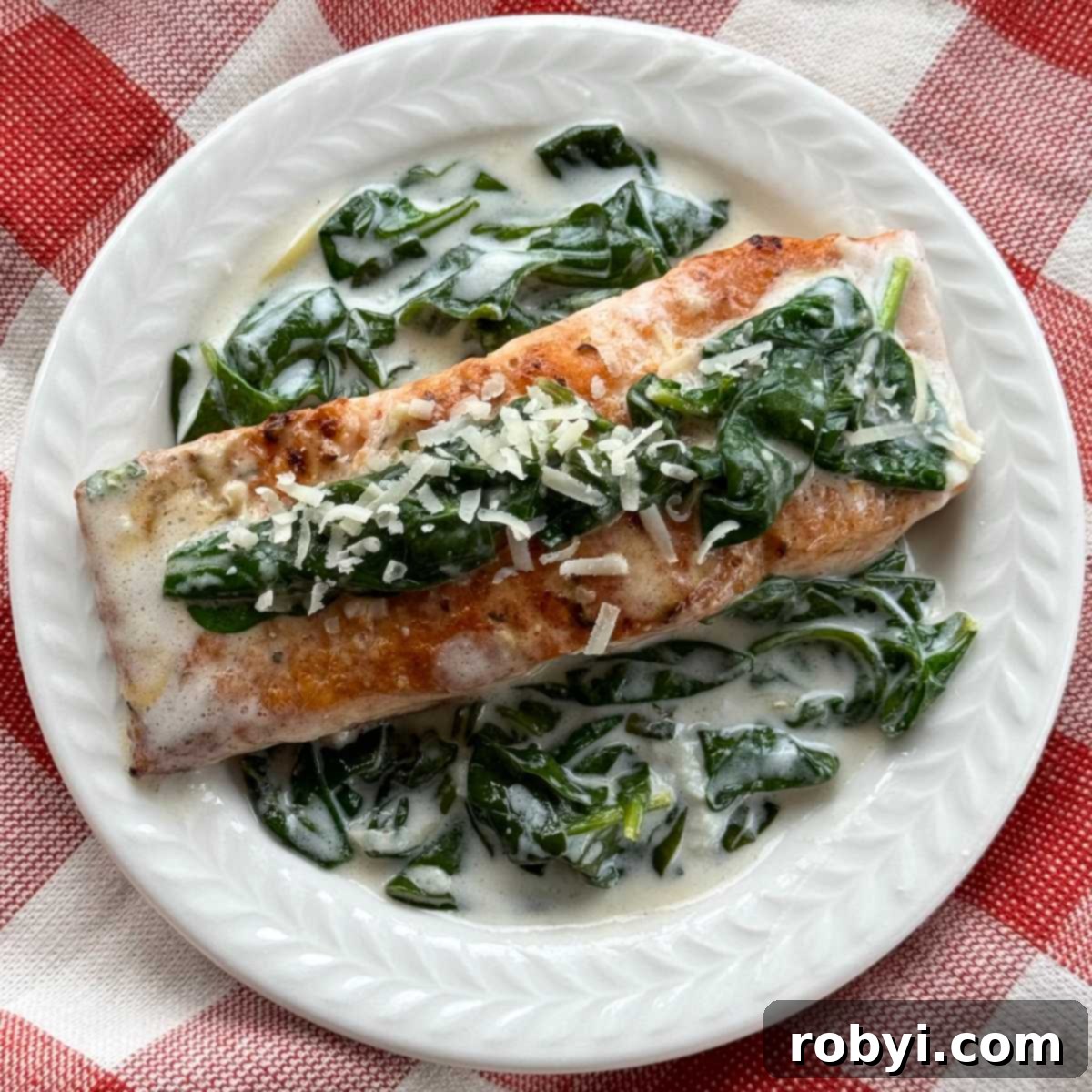
For those who cherish the delicate flavor of salmon and the nutritional power of spinach, this Salmon Florentine recipe is a revelation. It’s a harmonious blend of tender, flaky fish and a rich, velvety sauce that captures the essence of classic Italian-inspired cooking. Forget complicated, time-consuming meals; this recipe proves that sophisticated flavors can be achieved with minimal effort and cleanup, making it an ideal choice for busy evenings or when you want to impress without the stress.
Like the popular pairing of scallops with wilted spinach, this dish is a true one-pan wonder, simplifying your cooking process and ensuring a quick transition from kitchen to table. It artfully combines healthy salmon with a decadent Parmesan cream sauce, brightened by fresh spinach and a hint of lemon. If you’ve previously fallen in love with creamy spinach and artichoke chicken, you’ll find a similar comforting richness in this salmon variation, making it a guaranteed family favorite that’s also keto-friendly.
Here are even more compelling reasons to make this recipe your next go-to meal:
- This quick and easy recipe is ready in under 30 minutes, perfect for swift weeknight meals.
- Enjoy the convenience of only one skillet to clean, streamlining your post-dinner routine.
- It offers an elegant presentation, making it suitable for both casual weeknight dinners and special occasions.
- It combines the significant health benefits of lean salmon and nutrient-dense spinach into one incredibly delicious dish.
What is Salmon Florentine? A Culinary Classic Explained
The term “Florentine” in culinary arts traditionally refers to dishes prepared “in the style of Florence,” typically incorporating spinach as a key ingredient, often with a creamy sauce or cheese. This Salmon Florentine recipe perfectly embodies that tradition by pairing succulent salmon with a luxurious, cheesy spinach cream sauce. It’s a testament to how simple, fresh ingredients can create a meal that feels both comforting and gourmet. The richness of the Parmesan cream sauce beautifully complements the delicate texture and flavor of the salmon, while the fresh spinach adds a touch of earthiness and vibrant color. This dish is not just a meal; it’s a celebration of classic flavors and straightforward cooking.
Essential Ingredients for Your Creamy Salmon Florentine
Crafting this delicious Salmon Florentine requires a handful of fresh, high-quality ingredients. Each component plays a crucial role in building the dish’s incredible flavor and texture:
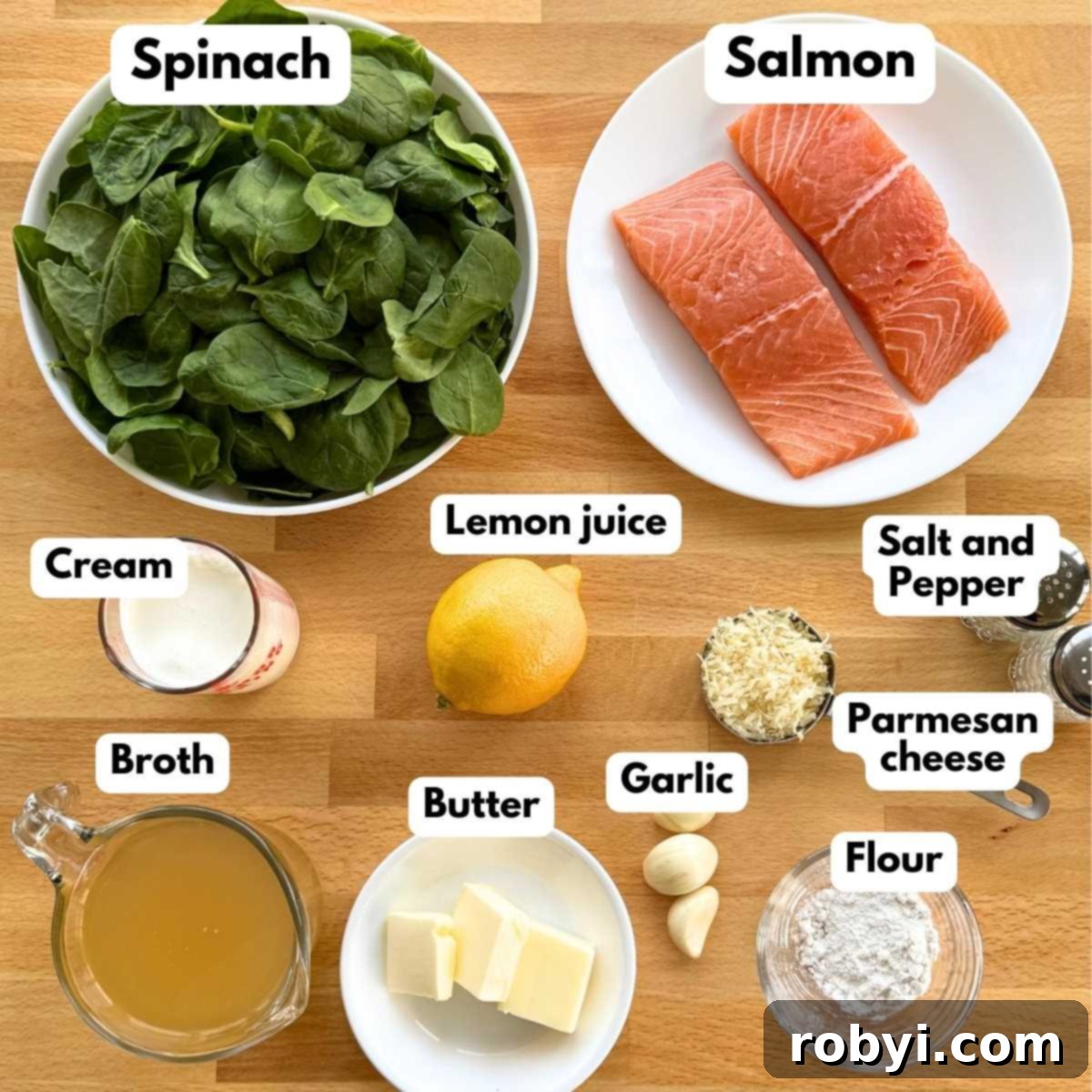
- Boneless, Skinless Salmon Fillets: Opt for high-quality salmon fillets, about 1-inch thick, for best results. While skinless is convenient, you can certainly use skin-on fillets; the skin becomes crispy and is easily removable after cooking if desired. Freshness is key, so look for firm flesh and a vibrant color. Salmon is not only delicious but also packed with heart-healthy Omega-3 fatty acids, making this dish a nutritious choice.
- Fresh Baby Spinach Leaves: Baby spinach is preferred for its tender leaves and mild flavor. You can leave the leaves whole, or if they are particularly large, a rough chop works well. Removing hard stems can improve the texture, though for tender baby spinach, it’s often unnecessary. If fresh spinach isn’t available, frozen cut-leaf spinach can be used. Ensure you defrost it completely and press out all excess water before adding it to the sauce to avoid a watery consistency.
- Heavy Whipping Cream: This is the foundation of our luscious cream sauce. Heavy cream delivers unparalleled richness and creaminess. For a slightly lighter sauce, you can substitute with half and half or whole milk, but keep in mind that the higher the fat content, the more decadent and stable your sauce will be.
- Chicken or Vegetable Broth: Choose a low-sodium chicken or vegetable broth to control the overall saltiness of the dish. Broth adds depth and helps to achieve the perfect sauce consistency without making it overly heavy.
- Grated Parmesan Cheese: Freshly grated Parmesan cheese melts beautifully into the sauce, contributing a salty, nutty, and umami flavor that is characteristic of Florentine dishes. Avoid pre-shredded cheese, which often contains anti-caking agents that can hinder smooth melting.
- Butter: Used for searing the salmon and creating the roux for the sauce, butter adds a rich, savory base. You can substitute one tablespoon of butter used for cooking salmon with olive oil if preferred.
- Minced Garlic: Fresh garlic is essential for an aromatic and flavorful sauce. Minced garlic infuses the cream sauce with a pungent, sweet undertone that complements the other ingredients.
- All-Purpose Flour: A small amount of flour is used to create a roux, which thickens the sauce, giving it a smooth and velvety texture. For a gluten-free option, you can substitute cornstarch (slurried with a bit of water or broth) or a gluten-free flour blend.
- Fresh Lemon Juice: A squeeze of fresh lemon juice at the end cuts through the richness of the cream sauce, adding a bright, zesty tang that elevates all the flavors in the dish. Don’t skip this critical element!
- Salt and Pepper: Essential for seasoning the salmon and adjusting the flavor of the cream sauce to your preference.
Please refer to the recipe card below for the full list of ingredients and detailed instructions.
Step-by-Step Guide: How to Make Salmon Florentine on Your Stovetop
Follow these simple steps to create a truly delicious Salmon Florentine with a creamy spinach sauce, right on your stovetop:
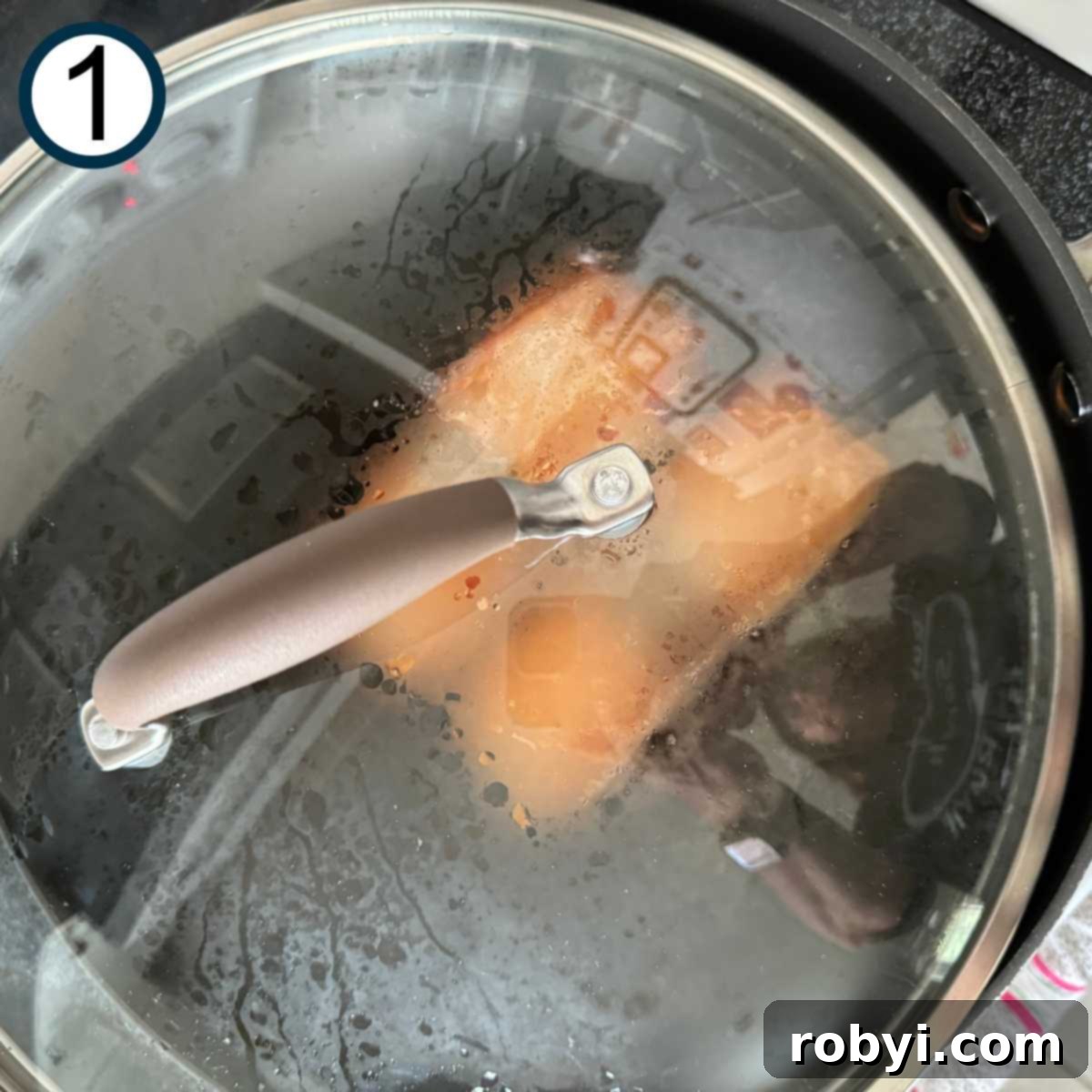
Step 1: Prepare and Sear the Salmon. Pat your salmon fillets completely dry with a paper towel. This crucial step helps achieve a beautiful, crispy sear. Season both sides generously with salt and freshly ground black pepper. Melt 1 tablespoon of butter (or olive oil) in a large non-stick skillet over medium-high heat. Once the butter is shimmering, place the seasoned salmon fillets in a single layer in the pan. Avoid overcrowding; cook in batches if necessary. Sear for 4-5 minutes on each side, or until the salmon is beautifully browned and cooked through. The internal temperature should reach 145°F, or it should flake easily with a fork. (Refer to our “Top Tips” below for more on cooking salmon to perfection).
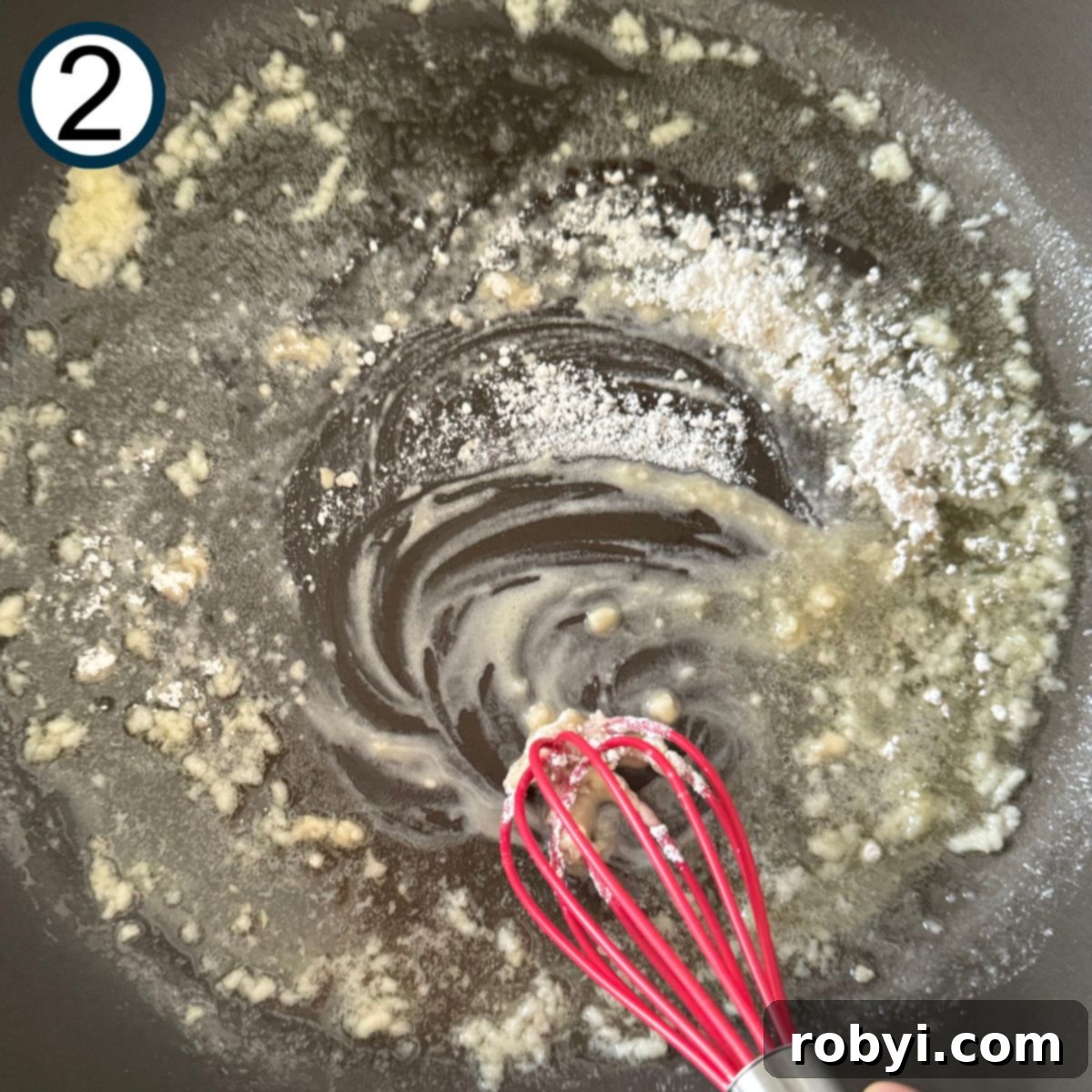
Step 2: Start the Cream Sauce. Once the salmon is cooked, carefully remove it from the skillet and transfer it to a serving dish. Tent it loosely with aluminum foil to keep it warm while you prepare the sauce. In the same pan, melt the remaining butter over medium heat. Add the minced garlic and sauté for about 1 minute until fragrant. Be careful not to burn the garlic. Next, sprinkle in the flour and stir continuously for about 1 minute to create a smooth roux. This mixture will serve as the thickening agent for your creamy sauce.
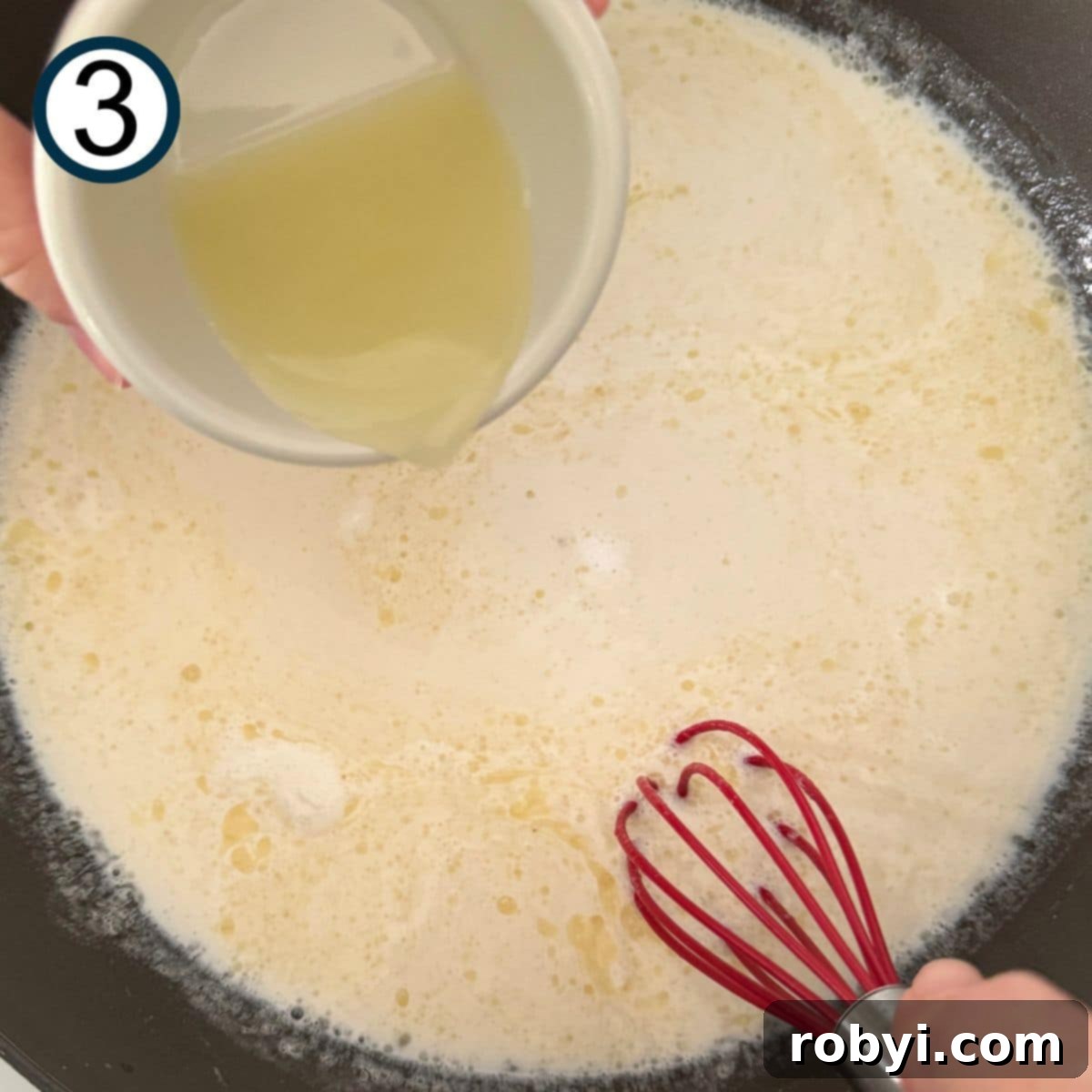
Step 3: Build the Creamy Parmesan Sauce. Pour in the heavy cream, chicken (or vegetable) broth, and fresh lemon juice into the skillet, whisking constantly to ensure there are no lumps from the roux. Stir in the grated Parmesan cheese until it fully melts into the sauce. Bring the cream sauce to a gentle boil over medium-high heat, then immediately reduce the heat to medium-low. Let it simmer for about 5 minutes, whisking occasionally, until the sauce thickens slightly and achieves a luxurious, creamy consistency. Taste and adjust seasoning with salt and pepper as needed.
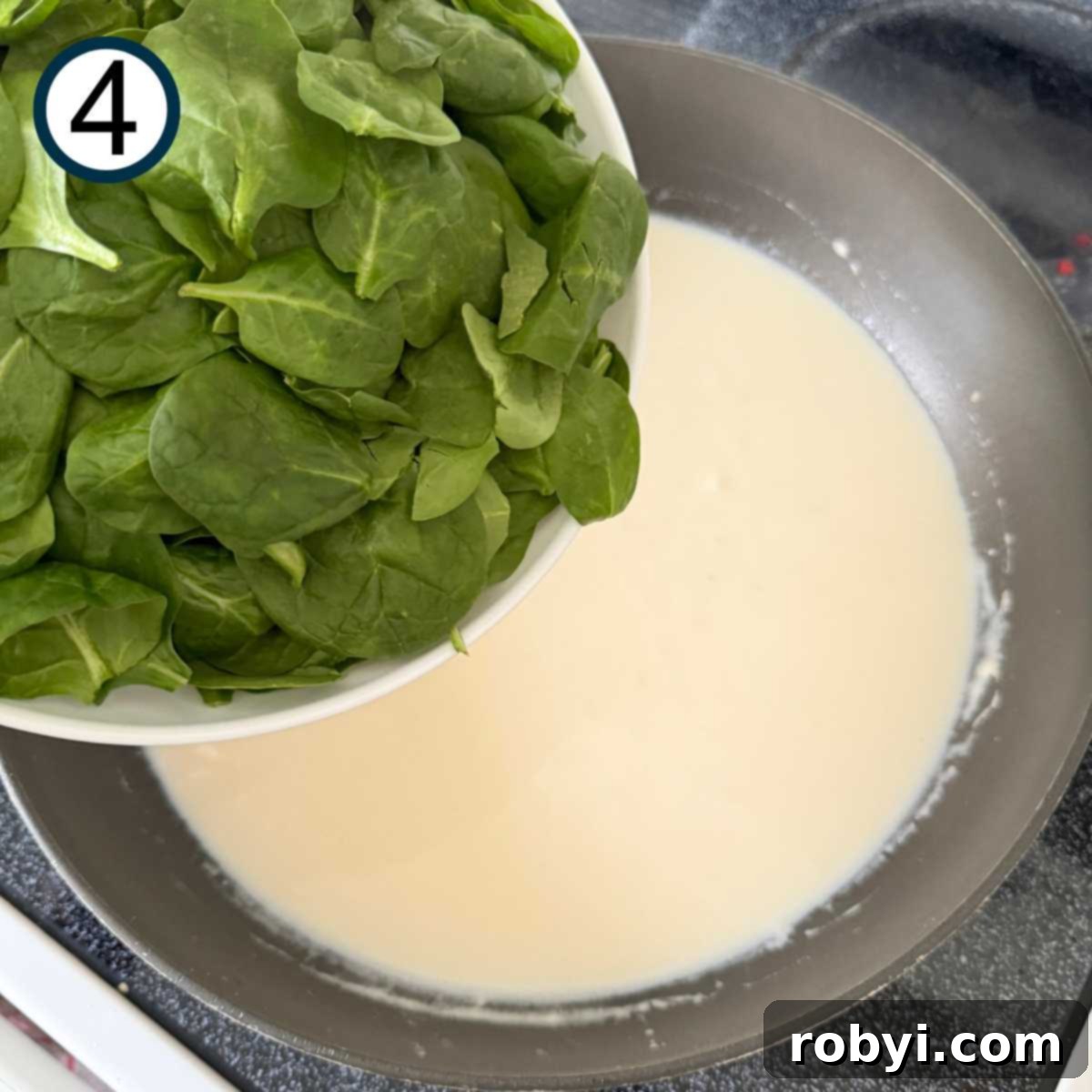
Step 4: Wilt the Spinach. Add the fresh baby spinach leaves to the simmering cream sauce. Stir gently, allowing the spinach to wilt down into the sauce. This usually takes just a few minutes. The spinach will release some moisture and integrate beautifully with the creamy base, adding both flavor and color.

Step 5: Final Assembly and Serve. Gently return the cooked salmon fillets to the skillet, nestling them into the creamy spinach sauce. Spoon the luscious sauce generously over the top of each fillet. Serve immediately, garnished with an extra sprinkling of grated Parmesan cheese, a fresh lemon wedge for an extra burst of zest, and a flourish of fresh parsley. Enjoy this restaurant-quality meal made effortlessly at home!
Note: If you prefer the taste and texture of baked or grilled salmon, feel free to use your preferred cooking method for the fish, and simply prepare the creamy Florentine sauce separately on the stovetop. Then combine and serve as directed!
Pro Tips for the Best Salmon Florentine
- Avoid Overcooking the Salmon: This is the most crucial tip for moist, flaky salmon. Salmon is done when it easily flakes with a fork and its internal temperature reaches 145°F, according to FDA guidelines. A good instant-read thermometer is your best friend here. Since the fish will continue to cook slightly after being removed from the heat (carryover cooking) and while resting, you can often remove it from the skillet at around 140°F, and it will reach the perfect temperature under its foil tent. Overcooked salmon becomes dry and tough.
- Achieve a Perfect Sear: Always pat your salmon fillets thoroughly dry with paper towels before seasoning and placing them in the hot pan. Moisture on the surface prevents the salmon from browning and developing that desirable crispy crust. Ensure your skillet is hot enough before adding the fish.
- For Thicker Fillets: If you’re working with thicker salmon fillets (over 1 inch), partially covering the skillet with a lid after searing the first side can be very helpful. This traps heat and moisture, allowing the fish to cook through evenly without the bottom becoming too browned or burnt.
- Adjust Sauce Consistency: If your sauce is too thick, thin it out with a splash more broth or cream. If it’s too thin, let it simmer gently for a few more minutes, stirring occasionally, to reduce and thicken.
- Fresh Lemon Brightness: Don’t underestimate the power of fresh lemon juice. A final squeeze or some zest just before serving adds a crucial burst of acidity that brightens the rich, creamy sauce and enhances the flavor of the salmon.
- Freshly Grated Parmesan: For the best flavor and smoothest sauce, use freshly grated Parmesan cheese. Pre-grated varieties often contain cellulose or anti-caking agents that can make the sauce grainy.
Storage and Reheating
Should you have any delectable leftovers of this Salmon Florentine, store them properly to maintain their quality. Place the fish and sauce in an airtight container and refrigerate for up to 2 days. While still delicious, the texture of salmon can change slightly upon reheating.
To reheat, gently warm the salmon and sauce over low heat in a covered skillet on the stove. Alternatively, you can microwave it on 50% power in short 30-second bursts until it’s heated through, stirring the sauce between intervals. Be careful not to overheat, as this can dry out the salmon.
What to Serve with Salmon Florentine
Elevate your creamy Salmon Florentine meal even further with thoughtfully chosen side dishes. Here are some fantastic pairings:
- Crispy Green Side Salad: A simple salad with a light vinaigrette provides a refreshing contrast to the richness of the Florentine sauce.
- Roasted Potatoes: Roasted fingerling potatoes, new potatoes, or even simple roasted potato wedges offer a satisfying starch.
- Pasta or Rice: Serve the Salmon Florentine over a bed of al dente pasta (like linguine or fettuccine) or fluffy white or brown rice to soak up every drop of that incredible sauce.
- Cauliflower Rice or Mashed Cauliflower: For a low-carb alternative, these options pair wonderfully with the creamy sauce.
- Steamed or Roasted Vegetables: Asparagus, green beans, or broccoli florets are excellent choices, adding color and nutrients.
- Crusty Whole-Grain Bread: Perfect for dipping into the exquisite Parmesan cream sauce.
More Delicious Salmon Recipes to Try
If you loved this Salmon Florentine, you might enjoy exploring other fantastic ways to prepare this versatile fish:
- Easy Crab Stuffed Salmon Recipe
- Bourbon Marinated Salmon – Easy Recipe!
- Phyllo Wrapped Salmon with Pesto and Cheese
Would you like more easy, healthy, carb-conscious recipes delivered straight to your inbox?
Easy Salmon Florentine Recipe
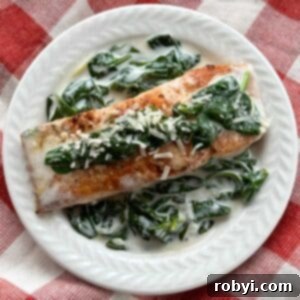
Easy Salmon Florentine Recipe
Whip up this easy Salmon Florentine recipe with fresh spinach and a luscious Parmesan cream sauce in just 30 minutes on the stovetop!
Prep Time: 5 minutes
Cook Time: 20 minutes
Total Time: 25 minutes
Servings: 4 servings
Author: Marjory Pilley
Ingredients
- 1 pound salmon fillets, boneless, skinless
- Salt and pepper to taste
- 2 Tablespoons butter, divided; olive oil can be substituted for 1 Tablespoon of butter used to cook the salmon
- 1 Tablespoon flour
- 3 garlic cloves, minced
- Juice of 1 lemon, about 2 Tablespoons
- 1 cup chicken broth, low salt; or vegetable broth
- ½ cup heavy cream, half and half or whole milk can be used
- ¼ cup grated Parmesan cheese, 0.5 ounces
- 2 -3 cups baby spinach leaves, roughly chopped if preferred
Instructions
- Pat salmon dry with a paper towel and season with salt and pepper.
- Melt 1 Tablespoon of butter in a large skillet over medium-high heat.
- Place salmon in a single layer in the pan, working in batches if necessary.
- Cook salmon for 4-5 minutes on each side or until browned and cooked through.
- Remove salmon to a serving dish and keep warm.
- Melt the remaining butter in the pan. Add minced garlic and cook for about 1 minute.
- Add flour and stir to create a roux, about 1 minute more.
- Whisk lemon juice, broth, heavy cream, and Parmesan cheese into the skillet.
- Bring the cream sauce to a boil over medium-high heat and then reduce to medium-low. Simmer for about 5 minutes or until slightly thickened and creamy, whisking occasionally throughout.
- Add spinach to pan and simmer a few minutes more to wilt the spinach.
- Pour Parmesan cream mixture over salmon and enjoy immediately.
Notes
See step-by-step pictures, serving ideas, and more above!
Top Tips:
- Don’t overcook the salmon. It should easily flake with a fork but will be a shade of pink and moist depending on the type of salmon. It’s done when the internal temperature reaches 145°F according to the FDA. Use an instant-read thermometer to check it. Since the fish rests while you’re making the sauce, you can usually remove it at 140°F, and it will come up to the proper temperature if it’s covered.
- If the salmon fillets are thick, partially cover the skillet with a lid after cooking the first side. This step will trap the heat and moisture, and cook it through before the bottoms become too brown.
Storage and Reheating:
Store leftover salmon Florentine in an airtight container in the refrigerator for about 2 days.
To reheat, warm fish and sauce over low heat in a covered skillet on the stove or microwave on 50% power in short bursts until heated through.
Nutrition
Calories: 393kcal | Carbohydrates: 6g | Protein: 28g | Fat: 29g | Saturated Fat: 14g | Polyunsaturated Fat: 4g | Monounsaturated Fat: 8g | Trans Fat: 0.3g | Cholesterol: 124mg | Sodium: 432mg | Potassium: 897mg | Fiber: 1g | Sugar: 1g | Vitamin A: 4787IU | Vitamin C: 13mg | Calcium: 141mg | Iron: 2mg
Nutritional and Food Safety Disclaimer
